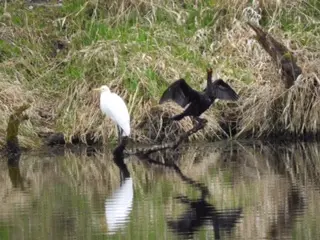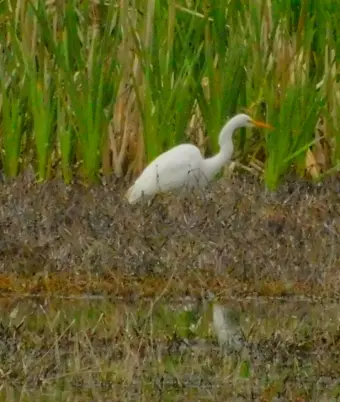No Egrets, CPTC!
by Marcia Wilson
A few months ago, something startling happened at the college wetlands. It was large, white, and Dr. Faust initially thought someone had dropped a mass of litter and it was now blowing around the snags on the south bank of Pond #4. Many a student can verify the power of wind and water in delivering all sorts of man-made objects into the Flett Creek Marsh. He soon realized there was nothing ‘trashy’ about it.

Co-incidentally, the school was fortunate that one of our volunteers, Cherie St. Ours, was present to break down this rare beauty. Included is a cormorant and it may help the viewer appreciate the size.
Casual Formal
Egrets were once a casual sight among North American wetlands, but their beautiful white feathers became a fashion statement until about the 1920’s. While it is hard to believe now, these feathers were worth twice their weight in market gold. To put this in a mathematical concept that Prof. Dion Alexander would approve, in 1902, London alone paid for over 1.5 tons of Great Egret feathers for fashion, and this required the slaughter of over 200,000 live egrets. These numbers do not include loss of eggs and young. The birds were often shot at their most vulnerable: while they were on their nests or watching their chicks.
While unproven, it may be the reason for the existence of an odd riddle: Which is more: a pound of feathers, or a pound of gold?

John James Audubon, the controversial bird artist, failed to catch the beauty of the Great White Egret. He tried yet fell short of his own expectations for eleven years. This is not surprising. The bird is large, liquid, and its white feathers make it difficult to translate the subtle hues and shades of overlapping white, ivory, and bone tints with its lozenge-shaped body. The egret’s beauty was a leading cause for its wholesale slaughter but also led to its becoming a conservation emblem of the Audubon Society.
Go East, Young Bird
CPTC’s Egret has been living happily on a diet of small fish and crayfish. After it has rested from the strain of migration it will vanish as mysteriously as it came, leaving behind many adoring birdwatchers. Perhaps it was originally from the potholes of Eastern Washington, a popular rookery over the mountains.

